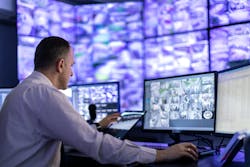How AI is transforming the video surveillance sector
By combining video data with other sources of information, the latest AI-powered solutions can not only recognize objects and events but also understand complex human behaviors and interactions. The result is a giant leap forward — from tools of passive observation to those of proactive, intelligent action.
The real-time monitoring of dozens of camera scenes is a tedious and exhausting task for humans. Effectively monitoring hundreds of cameras by human operators alone is nearly impossible. Even with limited video streams to observe, people struggle to identify unusual events or comprehend intricate patterns, especially over the long term. As human operators become fatigued with too much to monitor, false alerts are common and critical events are sometimes missed.
AI-Driven Analytics — a Game Changer
The latest AI-driven video analytic solutions provide automated scene understanding, behavior analysis and anomaly detection — which alleviate the human operators' workload. By continuously scanning and monitoring video data, AI can spot anomalies and bring critical events to the attention of decision-makers.
AI-driven video analytic solutions offer vast data processing capacities and can be integrated within a video management platform and deployed across a near-limitless number of cameras for full 24/7 coverage. Over time, the algorithms even get smarter in recognizing standard behavior patterns and identifying emerging threats. Some real-world examples of how AI analytics enhances security operations:
- Recognizing dangerous human interactions like fighting, falls or criminal activities
- Understanding crowd behavior to detect early signs of trouble
- Identifying important objects like weapons or unattended bags
- Detecting anomalies like perimeter intrusion
- Analyzing long-term trends to predict risks before incidents occur
- Correlating data from other facility systems like access control, LPR, audio detection systems and other sensor systems for a unified security solution.
With these capabilities, AI allows operators to focus their attention where it matters most — using human judgment to validate insights and determine the best response.
The Future of AI in Surveillance
AI enables security systems to operate with more accuracy, speed, scalability and human-like understanding than ever before. Smart technology will continue to transform how security professionals monitor, comprehend and act upon potential threats to safety and security.
In the very near future, AI breakthroughs will further transform the video surveillance sector on multiple fronts with new tools such as:
Advanced Algorithms: With neural networks and deep learning, AI tools keep improving at understanding human behavior, predicting incidents and recognizing potential threats.
Large Language Models (LLMs): LLMs combined with video (LVMs) allow operators to query surveillance systems with voice commands or text will make security operations more intuitive. Systems can understand human language requests and respond with relevant video clips or analyzed insights.
Increased Automation: Solutions using robotic process automation handle basic tasks like retrieving data and freeing up personnel to focus on value-adding activities. Machines can rapidly search vast video data archives to locate scenes, people, vehicles or other objects based on a detailed list of identification description keywords and learned and observed behaviors.
Generative AI: Emerging techniques can produce synthetic but very realistic video simulations for better anonymized analytics training and system testing. As the technology matures, it may one day create simulated emergency scenarios to evaluate and improve human response protocols.
Regulations and Consumers
Demand Responsible Use
In addition to new tools and capabilities, AI technologies will transform the video surveillance sector by ushering in new AI development and use regulations, as well as the need to address user and public consumer responsible-use concerns.
In October of this year, President Joe Biden signed an Executive Order on the Safe, Secure, and Trustworthy Development and Use of Artificial Intelligence, and just recently the EU AI Act was agreed upon and will soon become law.
While AI unlocks immense potential for video surveillance, its development and application bring considerations around privacy and transparency. Understanding these concerns, a recent 2023 global survey commissioned by Milestone Systems found that 85% of technology buyers expect responsible use of AI and video analytics as a prerequisite for engaging tech companies in the future.
AI regulations are changing the path of video technology development. So, how can providers ensure their AI solutions are being developed and used responsibly?
Within today’s emerging AI regulation environment, it would be prudent for any development company to align their development processes with the G7 Code of Conduct and, specifically, these relevant technology development principles:
- Take appropriate measures throughout the development of advanced AI systems, including prior to and throughout their deployment and placement on the market, to identify, evaluate, and mitigate risks across the AI lifecycle.
- Identify and mitigate vulnerabilities and, where appropriate, incidents and patterns of misuse after deployment, including placement on the market.
- Invest in and implement robust security controls, including physical security, cybersecurity and insider-threat safeguards across the AI lifecycle.
- Develop and deploy reliable content authentication and provenance mechanisms, where technically feasible, such as watermarking or other techniques to enable users to identify AI-generated content.
- Implement appropriate data input measures and protections for personal data and intellectual property.
In general, companies developing AI need to adopt a responsibility-by-design approach to development by building ethics, fairness and transparency very early in the design process. Implementing robust internal processes leads to effective preparation, but avoiding unnecessary risk matters too. The combination of innovation and responsibility strikes the right balance.
When creating AI systems, developers should prioritize user privacy and security from the start. This approach is outlined in GDPR legislation, which requires data protection by design and by default. It means building safeguards into the technology to protect personal data, limit data collection and use, and ensure ethical practices.
Transparency is a key principle in AI solution development that helps ensure that all stakeholders — including users, regulators, and society at large — can clearly understand the inner workings and decision-making processes of an AI system. It involves being open about how the system was developed, how it was trained, what data is used and how outcomes are reached.
Humans in the Loop
While AI can guide human operators with alerts and insights, the final decisions must come from people. AI is not about replacing security teams but augmenting their efforts for greater efficiency and precision.
As AI capabilities mature, video security is transforming into a proactive system. Instead of just documenting events after the fact, AI-enabled surveillance gives security teams the foresight they need to get ahead of threats in real time. It also creates a force multiplier effect, enhancing the productivity of human analysts.
Having a 'human in the loop' is an integral part of these solutions. A predictive model may be used to send an alert to prompt human operators to review the video and decide if action is needed. The more data the system has available to learn from and the more feedback it gets from operators, the smarter the software gets at making predictions.
AI is most effective when complementing human strengths — allowing personnel to leverage technology while retaining situational control and final decision authority based on training and judgment.
AI-powered video analytics promise immense transformational benefits, but also come with obligations around development, transparency, and use. With responsible practices that put people first, AI-augmented surveillance systems can usher in a new era of safety, security, and public trust.
By Rahul Yadav is Chief Technical Officer for Milestone Systems, bringing extensive experience leading technology organizations in diverse industries including media, public IT, consumer electronics, and telecommunications. Prior to joining Milestone, Rahul held various leadership roles at Bang & Olufsen, KMD A/S, TV 2 Danmark, Texas Instruments and Samsung Electronics. He holds a Global Executive MBA from INSEAD, Fontainebleau, France and a Master of Technology (M.Tech.) in Digital Communication from the National Institute of Technology, Bhopal, India.






